Van Gogh Museum Journal 1996
(1996)– [tijdschrift] Van Gogh Museum Journal–
[pagina 118]
| |
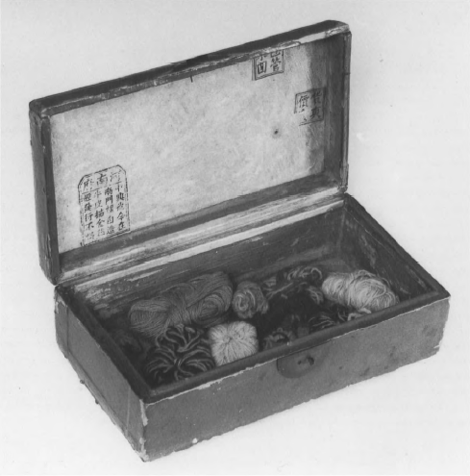 fig. 1
Vincent van Gogh's Chinese lacquer box with sixteen balls of wool, Amsterdam, Van Gogh Museum (Vincent van Gogh Foundation) | |
[pagina 119]
| |
Strands interlacing: colour theory, education and play in the work of Vincent van Gogh
| |
Van Gogh and colour theoryVan Gogh appears to have used this box of yarns not only to experiment with colour, as Bernard described, but also to help define the palette for specific pictures. Some of the balls of yarn can even be matched to particular paintings. A ball of harmonised yellow tones relates closely to Still life with white grapes, apples, pears and lemons (fig. 2),Ga naar voetnoot3 and another consisting of yellow, green and red yarns is comparable to Apples (Amsterdam, Van Gogh Museum). Since paintings with colour schemes like those of the balls of yarn first appear in the period when Van Gogh was in Paris and had had the chance to see impressionist painting, he probably did not assemble the yarns until he arrived there in March 1886. He certainly had them before he left for Arles two years later, since it was in Paris that Bernard met and worked with Van Gogh and later remembered seeing them. | |
[pagina 120]
| |
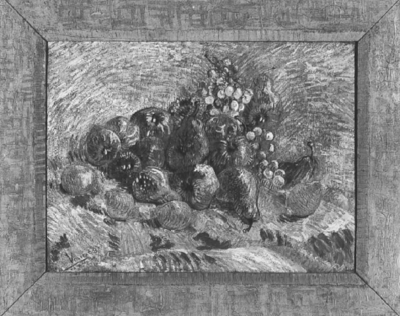 fig. 2
Vincent van Gogh, Still life with white grapes, apples, pears and lemons, autumn 1887, Amsterdam, Van Gogh Museum (Vincent van Gogh Foundation) Cornelia Peres was the first to point out that these balls of wool could provide information about Van Gogh's colour theory. Debora Silverman also discussed the box briefly in an intriguing article that explored the impact of the painter's Dutch upbringing on his art.Ga naar voetnoot4 She argued that the role of religion and the constraints on individuality in 19th-century Holland led Van Gogh to consider his art as a kind of craft labour, and that he self-consciously emulated the Nuenen weavers in his paintings. With regard to the box of yarns, she pointed out that Van Gogh had used the same method as the chemist Michel-Eugène Chevreul, ‘operationalizing’ the chemist's discoveries. She claimed that while Van Gogh was in Nuenen, he simultaneously absorbed Chevreul's ideas and observed the weavers at work. In Paris, she wrote, he was exposed to new ways of painting and there ‘amplified the pre-existing lessons of paint as threads and colour as fiber to be worked into the fabric of the picture surface.’Ga naar voetnoot5 These effects, which initially appear as a ‘woven stroke’ in a few early Nuenen-period still lifes,Ga naar voetnoot6 and much more frequently in his Paris flower still lifes, are carried over into some of his later and most celebrated paintings, such as the Van Gogh Museum's Sunflowers. | |
[pagina 121]
| |
Van Gogh was already keenly interested in colour theory before arriving in France.Ga naar voetnoot7 He encountered it primarily in two publications by Charles Blanc, Les artistes de mon temps, in the chapter devoted to Delacroix,Ga naar voetnoot8 and the Grammaire des arts du dessin, in a special section on the laws of colour.Ga naar voetnoot9 Van Gogh's commitment to Blanc's ideas remained remarkably consistent, from the time he first mentions them in his letters to the end of his career.Ga naar voetnoot10 However, to understand why Van Gogh did not study colour theory with the help of yarn until he arrived in Paris, it is necessary to review in some detail how he understood that theory before leaving the Netherlands.Ga naar voetnoot11 Blanc's colour theory is the same in both publications, and is deeply indebted to Chevreul's De la loi du contraste simultané des couleurs (1839), which the chemist had published while he was head of the Gobelins tapestry works. Studying different colour combinations of dyed wool in tapestries, Chevreul had observed that a given colour is always influenced by the one next to it. To explain these effects, he formulated the laws of simultaneous and successive contrast.Ga naar voetnoot12 Although Chevreul intended his work primarily for decorative arts designers, he believed it could be useful to painters. This proved true, and it is not an exaggeration to say that nearly every late-19th century painter in France was familiar with at least some aspect of his work. However, Chevreul's book was long and technical, and most painters seem to have learned of his ideas the way Van Gogh did, through popular interpretations such as Blanc's, written specifically for fine artists.Ga naar voetnoot13 Silverman argued that it was his daily observance of the weavers in Nuenen that ‘activated’ Van Gogh to imitate thread and fiber with paint.Ga naar voetnoot14However, before arriving in Paris, Van Gogh used the woven stroke only in a few still lifes and in a way that hardly suggests fabric at all. He did not imitate weaving in his painting, use a threadlike stroke or appear to have used yarn to experiment with colour until later. This suggests that Van Gogh's exposure to certain ideas and ways of working then current in Paris were relatively more important than Silverman has implied. It seems that Van Gogh did not fully understand who Chevreul was until after he moved to the French capital.Ga naar voetnoot15 Not only was the chemist well known in Van Gogh's Parisian circle, but he also turned 100 the year the painter arrived and was celebrated as a national hero.Ga naar voetnoot16 One of the | |
[pagina 122]
| |
 fig. 3
Vincent van Gogh, Vase with asters and phlox, summer 1886, Amsterdam, Van Gogh Museum (Vincent van Gogh Foundation) places Chevreul's achievements were noted was in a remarkable and very early essay in photojournalism by Félix Tournachon, better known as Nadar. He interviewed him for Le journal illustré and accompanied the article, which included a discussion of colour theory, with photographs he had made during their conversation.Ga naar voetnoot17 In 1886, therefore, it would have been nearly impossible for Van Gogh not to have learned of the connection between Chevreul and the Gobelins tapestry works, and of the importance of his research for artists. During his Paris period, Van Gogh began to use strokes in his painting that strongly evoke cloth and thread, frequently in the backgrounds of his paintings. Significantly, Chevreul had pointed out that it was this area of a painting that often posed the greatest challenge to the artist and the place where his theories could be most useful.Ga naar voetnoot18 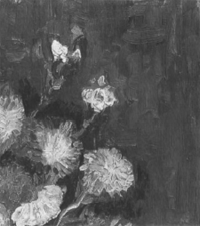 fig. 4
Vincent van Gogh, Vase with asters and phlox (detail of the top right corner) In Vase with asters and phlox (figs. 3 and 4), for example, the painting is keyed to Chevereul's simultaneous contrast of predominantly red and green flowers in the vase. In the background, brushstrokes of red and green are woven together to create a neutral but harmonious backdrop of what Blanc and Chevreul called tons rompus, an unequal mixture of complementary colours that allows one to dominate. In Vase with gladioli (figs. 5 and 6), Van Gogh draws on two different aspects of Chevreul's colour contrast harmonies described by Blanc. The foreground is again harmonised with a simultaneous contrast of primarily red and green,Ga naar voetnoot19 but the distinctly woven background is made of different shades of blue, creating a monochromatic contrast of analogous hues and tones, a harmony composed of that ‘infinite variety of tone of one same family’ Van Gogh first admired in Nuenen.Ga naar voetnoot20 While less common after 1886, the woven stroke does appear in some important later paintings, again usually in the background, and once as the rug, created out of red, green and yellow strokes, below Gauguin's armchair (fig. 7). | |
[pagina 123]
| |
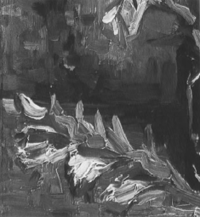 fig. 5
Vincent van Gogh, Vase with gladioli (detail of the lower left corner) While it is likely, as Silverman suggested, that Van Gogh sought to emulate the weavers in his painting for ideological reasons, these were not the only ones. Nor was he the only painter in Paris to evoke cloth in his work. An examination of Georges Seurat's recreation of the effects of tapestry in his work sheds more light on why making paintings that looked like fabric might have appealed to Van Gogh. As Jeroen Stumpel has argued, Seurat, who like Van Gogh was greatly interested in colour theory, consciously tried to imitate tapestry in his paintings.Ga naar voetnoot21 Both detractors and supporters of Neo-impressionism recognised the relationship between this painting style and textiles. Unfriendly critics called it ‘la méthode à petit point,’ and Seurat's work was compared to ‘painted Gobelins, just as unpleasant as the originals.’ On the other hand, in the pamphlet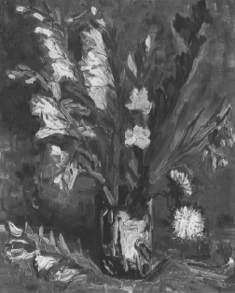 fig. 6
Vincent van Gogh, Vase with gladioli, summer 1886, Amsterdam, Van Gogh Museum (Vincent van Gogh Foundation) on the new technique that accompanied the work's exhibition in the spring of 1886, Seurat's influential friend and apologist Félix Fénéon admiringly described Sunday afternoon on the island of La Grande Jatte (The Art Institute of Chicago) as a ‘patient tapestry.’ For Seurat, imitation of the weaver's craft was a means of ridding his work of naturalism, adapting the highly popular decorative effects of tapestry to paint. As Stumpel noted, Blanc discussed the characteristics of tapestry at length in his Grammaire and how it differed from painting, concluding: ‘In the end it is fortunate that | |
[pagina 124]
| |
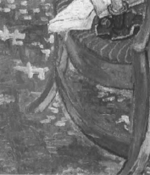 fig. 7
Vincent van Gogh, Gauguin's chair (detail of the lower left corner), November 1888, Amsterdam, Van Gogh Museum (Vincent van Gogh Foundation) the shortcomings of the art of weaving give it its most beautiful qualities by forcing it to be what it must be: simply decorative.’ Stumpel has proposed that Seurat radically challenged Blanc's conservative separation of painting from the decorative arts and ‘subjected painting to the principles of weaving.’Ga naar voetnoot22 The formal issues of naturalism that troubled Seurat were also ones with which Van Gogh wrestled. Van Gogh, however, consistently tried to find a synthesis between a representation grounded in nature and a decorative effect guided, in part, by colour theory. As a result, he often managed to create the decorative harmonies he sought not by changing the natural colours of objects, as other artists such as Paul Gauguin did, but rather by choosing subjects to paint that easily fit his colour theory. This helps explain why Van Gogh painted so many still lifes early on during his stay in Paris.Ga naar voetnoot23 In this genre, he had complete control over the subject and its composition. In a letter to the painter Horace Mann Livens in the fall of 1886, he frankly referred to his flowers as ‘a series of colour studies in painting, simply flowers, red poppies, blue corn flowers and myosotys, white and rose roses, yellow chrysanthemums - seeking oppositions of blue with orange, red and green, and yellow and violet seeking les tons rompus et neutres to harmonise brutal extremes. Trying to achieve intense colour and not grey harmony.’Ga naar voetnoot24 By carefully choosing his models, Van Gogh could at once create decorative pictures harmonised by the rules of simultaneous and successive colour, and a representation that was essentially true to nature.Ga naar voetnoot25 When Van Gogh felt he had begun to master colour in his painting in Paris, he applied the principles of colour theory more widely to other genres, such as landscapes, interiors, and portraits.Ga naar voetnoot26 | |
Froebel's ‘gifts’But what exactly prompted Van Gogh to roll balls of wool to explore colour theory? The answer springs from a surprising quarter: the kindergarten. The idea of learning about colour with balls of wool does not originate with Van Gogh, or even Chevreul. Rather, it can be traced to the German philosopher of education, teacher and creator of kindergarten, Frederick Froebel (1782-1852). Froebel was inspired by, yet critical of, the teaching practices of the Swiss educational reformer, Johann Heinrich Pestalozzi (1746-1827). Inventor of the ‘object lesson,’ Pestalozzi encouraged children to learn by doing rather than by copying.Ga naar voetnoot27 Froebel, however, believed that Pestalozzi's methods seriously neglected spiritual development, and his own Christian and mystical philosophy of education inspired him to develop revolutionary methods of teaching.Ga naar voetnoot28 Certain that early education had been woefully ignored, he began work on a new | |
[pagina 125]
| |
institution in the 1830s in Germany, one that would educate groups of children as young as three or four outside the home. He called this new establishment ‘kindergarten.’Ga naar voetnoot29 Froebel's theories and practices were grounded on the Lockean premise that ‘all intellectual development take[s] place through the senses.’Ga naar voetnoot30 Between 1835 and 1850, he developed didactic materials to help very young children learn. Later called ‘gifts and occupations,’ these learning tools were to be introduced to the children serially and formed an essential part of Froebel's method. Many made use of drawing, painting, building, modelling and weaving, and all the gifts and occupations were designed to encourage the children to learn through play.Ga naar voetnoot31 Probably the best known are the building blocks Froebel invented (fig. 8). Frank Lloyd Wright, for example, claimed in his autobiography that playing with a set of these ‘smooth shapely maple blocks’ helped inspire him to become an architect.Ga naar voetnoot32 The first ‘gift,’ described by Hermann Goldammer in the most important kindergarten manual, bears a striking resemblence to Van Gogh's lacquer chest: a ‘box containing six worsted balls crewelled over in different colours, three showing the primary colours - red, yellow, and blue - and three the secondary colours - green, violet, and orange’ (fig. 9).Ga naar voetnoot33 Intended to be introduced to infants well before they reached kindergarten, this gift was to be a lasting one. fig. 8
‘Sixth gift,’ from Edward Weibé, The paradise of childhood: a manual for self-instruction in Friedrich Froebel's educational principles and practical guide to kindergartners, Springfield, Mass. 1869 | |
[pagina 126]
| |
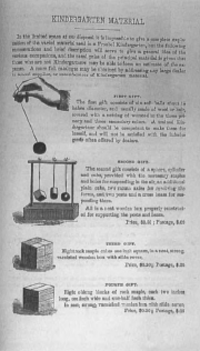 fig. 9
‘Kindergarten material,’ from Henry Barnard (ed), Kindergarten and child culture papers: papers on Froebel's kindergarten, Hartford 1884 Goldammer devoted his first chapter - 27 pages and 30 illustrations - to these balls of yarn (fig. 10), describing games that children could play with them from the age of three months through the kindergarten years and beyond. By the time the children came to kindergarten, they would have already learned their colours, in part by playing with the balls. As every gift and occupation was designed to express the essential harmony and unity of nature, Froebel and his followers believed that it was important not only that children be able to identify colours, but also that they understand the relationships among them. Writing in this instance about a game with coloured building blocks rather than balls, Froebel explained: ‘There still 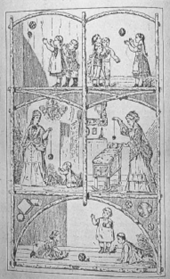 fig. 10
‘First gift,’ from Hermann Goldammer, The kindergarten: a guide to Froebel's method of education, gifts and occupations, Berlin, London & New York 1882 remains the change of colours. The colours must make amongst themselves a complete colour-harmony. For instance, red and green (green being made up of the other two primaries, blue and yellow); yellow and violet (violet being composed of blue and red); blue and gold or orange (orange being composed of red and yellow). [...] You see that the two harmonising colours in each varying combination and between them all the three primary colours. Now the colours may be grouped in all kinds of ways upon the same ground form, wherein we get true colour-games [...]. The essence of the game lies in each successive alteration of form or arrangement of colours [...] evolved [...] from the previously existing [...] form or colour.’Ga naar voetnoot34 | |
[pagina 127]
| |
The coloured balls could also be used in complex ways. Goldammer described exercises designed to introduce the children to sophisticated understandings of colour and colour harmonies. For, as Goldammer wrote, by the time a child is three or four, he ‘is no longer merely to receive a certain sum of impressions as formerly, but must be induced to make personal efforts, to observe, and to give expression to what he observes.’Ga naar voetnoot35 Songs associating colours with objects were to be followed by questions asking the children to come up with the names of other things that matched the colours of different balls.Ga naar voetnoot36 The spectrum could be demonstrated with two balls crewelled in different ways, with the bands of colours wrapping either longitudinally, meeting at the poles, or latitudinally, running parallel. Rotating the balls would give different effects: ‘The latter when made to revolve at the end of a string will show the image of a rainbow, the more distinct the quicker it revolves. In the former on the contrary the colours will become more and more indistinct as the speed increases, and will at length subside into a dirty black.’Ga naar voetnoot37 The concept of secondary colours, even of optical mixture, could also be demonstrated by spinning balls half covered with one primary colour, half in another.Ga naar voetnoot38 Although Van Gogh used his balls of yarn specifically in relation to his painting, which extended standard kindergarten practice, both he and the kindergartners who presented the ‘gifts’ believed that they were a simple yet useful and direct way to learn about the laws of harmony and contrast of colour. Significantly, the idea that underlies both Van Gogh's practice and Froebel's method is the same: that sensory experience and free experimentation - play, in other words - is the best way to learn. Van Gogh probably used his balls of wool in a number of ways. By imitating the colour combinations described by Blanc and others, the painter could see for himself the effects of the different colour medleys often described with few or no illustrations in texts on colour theory. With a particular subject in mind, he could also have tried out various colour combinations with yarn, as an inexpensive alternative to paint. Van Gogh never had enough money for all the paints he wished to buy. One can imagine him selecting, combining and recombining different coloured strands of yarn to help him decide which colours to invest in. It is notable that it was in Tanguy's shop, where Van Gogh bought most of his materials while he lived in Paris, that Bernard remembered seeing Van Gogh's box. Finally, keeping the box of yarns would have been a tidy and convenient way to save colour ‘symphonies’ he found particularly striking in order to study them again later. | |
Van Gogh and FroebelBut did Van Gogh know about Froebel's first gift when he wound his own balls of yarn? Since he does not actually mention Froebel in his letters, one can only speculate. Considering how widespread the kindergarten idea was by 1886, however, a good case for his familiarity with the German pedagogue can be made. During the last half of the 19th century, hundreds of kindergartens based on Froebel's method were established across Europe, in the United States, even as far away as Australia, India and Japan.Ga naar voetnoot39 By the time Van Gogh reached Paris, over two thousand books and articles specifically on Froebel, mostly in German but also in French, English and Dutch, had appeared.Ga naar voetnoot40 In 1857, the Barnoness Berthe von Marenholtz-Buelow, Froebel's well-connected, articulate and extremely effective disciple, introduced the idea of kindergarten to the Netherlands. There, Froebel's ideas received support in influential places.Ga naar voetnoot41 A friend of the barnoness, Elise van Calcar, translated Froebel into Dutch and promoted ‘the Cause’ in Holland for 35 years. The kindergarten, or as it is still known, Fröbelschool, thrived.Ga naar voetnoot42 | |
[pagina 128]
| |
Although Van Gogh would have been at just the right age for the gifts and occupations when kindergarten was brought to his native country, these progressive forms of teaching were probably not practiced so early in the small town of Groot-Zundert where he briefly attended the village school, nor would they have been known by his governess. As Van Gogh grew up, however, and the international kindergarten movement spread, he likely learned of Froebel's idea by word-of-mouth and through the press. One of Van Gogh's favorite writers, Jules Michelet, for example, wrote warmly of Froebel in his book on education, Nos fils.Ga naar voetnoot43 In his examination - which he based on readings by and about the pedagogue, a lively discussion with the Baroness von Marenholtz-Buelow, and on visits to a kindergarten - Michelet emphasised how Froebel's method fostered creativity.Ga naar voetnoot44 In an early article intended for a more general audience, an English writer, full of admiration for ‘a very interesting method of infant training,’ described a visit to a London kindergarten.Ga naar voetnoot45 Each of the teaching materials, including the coloured balls, is described in some detail.Ga naar voetnoot46 The author, the father of a ‘fine spirited two-year old baby,’ was particularly impressed with the indestructible, as well as educational nature of gifts. Another early piece in a popular magazine appeared in the weekly All the Year RoundGa naar voetnoot47 in which Charles Dickens published his serialised novels. Van Gogh read very widely in Dutch, English and French, and still other articles on the kindergarten appeared in publications he is known to have enjoyed.Ga naar voetnoot48 Few now remember the gifts and occupations that formed such a central part of Froebel's kindergarten. This, however, would not have been the case 100 years ago. Froebel's early disciples encouraged orthodoxy, not only in theory but also in practice. An article in Lippincott's Magazine recounted the extensive training of a young ‘kindergartner’ and followed her through her teaching session.Ga naar voetnoot49 ‘To all “improved” suggestions,’ the author wrote, ‘she gave a peremptory negative. Mrs. K-'s Froebelian models, pure and simple, were the only ones she would tolerate.’Ga naar voetnoot50 Describing the key role colour played in Froebel's teaching, the teacher explained: ‘We use color continually in combinations that are always governed by laws of harmony. One of the prettiest of our gifts is the colored geometrical tablets or plane figures. The children are | |
[pagina 129]
| |
led to arrange them in numberless forms of beauty, forms of knowledge and forms of life (so Froebel classifies them); and in this kind of play, guided by the system the kindergartner has learned, they unconsciously become as familiar with the shapes, the relations and the composition of all geometrical figures as they are with their dolls and marbles. But every combination made with different colors must be laid down with harmony. The habit of doing this develops a sensitiveness to harmonious or discordant effects like that produced in an ear thoroughly accustomed to harmony and guarded from discord in music.’Ga naar voetnoot51 Descriptions of the gifts and occupations published in many languages, such as Goldammer's Guide and Barnard's Kindergarten papers,Ga naar voetnoot52 made certain that Froebel's methods were not only widely disseminated, but could also be closely imitated. Froebel's gift of weaving, for example, described and illustrated in popular kindergarten manuals, is featured in Harper's Magazine (fig. 11). Many teachers adopted these methods in their classrooms but it appears Van Gogh was the only artist to adapt Froebel's widely-known first gift for his use as a painter. | |
Van Gogh and art education reformHowever exceptional Van Gogh's box may be, it should be noted that certain progressive methods of general education, which emphasised individuality, creativity, and the arts (usually in the form of drawing and design) were clearly relevant to the waves of reform in fine-art education that swept Europe in the second half of the 19th century.Ga naar voetnoot53 While the system of academic training for a fine artist was not dismantled overnight, and it took a very long time before the idea of self-education for an artist was widely accepted as an alternative - or even a complement - to regular training,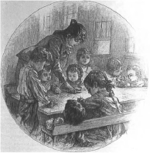 fig. 11
‘Weaving,’ from ‘A free kindergarten,’ Harper's New Monthly Magazine 57 (November 1878) ultimately the time-honoured system collapsed. The reasons for its persistence, then eventual demise, are complex, but it can be argued that progressive general education practices, which date from about the 1830s and culminated in universal, free and compulsory education across Europe by the end of the century, played a role in the steady erosion of traditional art education. Changes in art education cannot be considered apart from these broader changes. Methods such as Froebel's, which made extensive use of art and craft materials to foster expression and creativity in very young children, in an environment where children make instead of copy, find a complement in the new ways of teaching drawing not only to future artists, artisans, designers or engineers, but also to all school-age children as part of their general education. Proponents of these methods | |
[pagina 130]
| |
attacked the dessin copié, the traditional foundation of an artist's education, and instead suggested means that consisted of one or more of three components: descriptive geometry, drawing after nature, or drawing from memory.Ga naar voetnoot54 These new approaches gained the attention and even support of some fine-art academicians, those who had the greatest stake in preserving the customary system. To cite but one interesting example, the Belgian Louis de Taeye, professor of art at the academy at Louvain, insisted that drawing instruction - not only for would-be artists but for every school child - be based on a program that first introduced students to the principles of geometric drawing and then to drawing after nature. He argued this point in his influential book on the state of drawing instruction in Belgium, which also included a history of drawing instruction stretching back to Antiquity.Ga naar voetnoot55 To justify his own position, De Taeye put himself and his method in line with the theorists and practioners of modern progressive education, mentioning among others Coménius, Rousseau, Helvétius, Pestalozzi and Froebel. Although De Taeye believed some of Froebel's methods were too sophisticated for very young children, he clearly recognised the importance of his concept of art education, devoting a chapter of his book to ‘Les écoles Froebel.’Ga naar voetnoot56 Summarizing the reformer's contribution, De Taeye wrote: ‘In his Education of man, the creator of kindergarten analyses at length the importance of artistic study. He demonstrates the usefulness of art, presents a method of drawing for the youngest children, initiates the young student to the knowledge of colours and has them resort to [...] generalization. [...] It is necessary to lovingly study works of art, says Froebel, and it is necessary to initiate all students to an intuition of form.’Ga naar voetnoot57 Progressive theory dictated that the creative, expressive aspects of a child's nature had to be taken into account. This would have held great appeal for someone like Van Gogh, who was interested in primitivism; perhaps by imitating the creative play of children and methods of the kindergarten,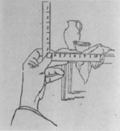 fig. 12
Drawing from Camille Bellanger, Traité de peinture à l'usage de toute le monde, Paris [1888] he believed he could tap into the spontaneous, naive, creative expressiveness associated with children. Progressive pedagogues also hoped to create a school environment where children essentially educated themselves. While theory often diverged from practice, the implications of this idea can be related to the option increasingly open to students of art in 19th-century Europe, that of acquiring some of their training independently. This was especially true of drawing, which could be self-taught with any one of a great range of manuals.Ga naar voetnoot58 As is well known, Van Gogh himself followed independently and painstakingly two of Charles Bargue's courses in order to master drawing.Ga naar voetnoot59 It took longer for painting instruction to emerge from the almost sacred confines of the studio system, but by the end of the century strong evidence of change emerges, and not only among the avant-garde. The traditionally-trained history and genre painter Camille Bellanger, for example, published a manual in 1898 for art students that provided a complete course of self-instruction in drawing and painting.Ga naar voetnoot60 This program entailed a wholesale rejection of copying and emphasised learning by trial and error. Notably, begin- | |
[pagina 131]
| |
ning students of painting were strongly encouraged to begin as Van Gogh had in Etten, and later as he taught in Nuenen, that is with simple, original compositions in still life (fig. 12). Many of the ideas specifically associated with an artist's traditional training in the late 19th century, such as a familiarity with the rudiments of colour theory, experience with different kinds of materials, and an initiation to the ‘intuition of form’ were increasingly becoming an integral part of even a very young child's education. Furthermore, progressive theories like Froebel's challenged the widely-held notion of the artist-genius. Proponents assumed that every child had the potential, even the need, to be creative and expressive, and that these ‘artistic’ qualities were essential to the learning process. But these pedagogues also recognised that these impulses in children needed to be encouraged and that techniques to channel expression had to be taught. This had both negative and positive implications for artists. It irrevocably undermined their special status as chosen recipients of the gift of creative vision and expression, but it also granted them a certain power over the cultivation of their talents. Still, the notion of genius remained extremely potent, and even today the conflict between competing ideas of art making as a process and a product of education on the one hand, and art making as the result of divinelike inspiration on the other, remains unresolved. While the impact of both conceptions often can be found in Van Gogh's way of teaching himself, working process and writing, the tension between them is nowhere more apparent than in his equivocal statement on genius: ‘The laws of colour are unutterably beautiful, just because they are not accidental. In the same way that people nowadays no longer believe in fantastic miracles, no longer believe in a God who capriciously and despotically flies from one thing to another, but begin to feel more respect and admiration for and faith in nature - in the same way, and for the same reasons, I think that in art, the old-fashioned idea of innate genius, inspiration, etc., I do not say must be put aside, but thoroughly reconsidered, verified - and greatly modified. However, I do not deny the existence of genius, or even its being innate. But I certainly do deny the inference that theory and instruction should, as a matter of course, always be useless.’Ga naar voetnoot61 This statement came at a time when Van Gogh had been working hard to teach himself to paint and to master the basics of colour theory on his own. One way to explain his reservations about genius and his determined course of self-instruction is the influence of contemporary ideas about the creative process of learning, the expressive nature of the child and progressive methods of education. In this essay, I have discussed three ways in which the origin of Van Gogh's box of coloured balls of yarns, and the way the artist experimented with the balls of wool, can be associated with contemporary theories and practices of education. First, he used the yarns to help master colour theory, which he believed would improve his painting. As I have shown, this should be related to one of the broadest tenets of progressive pedagogy which held that everyone can be creative and expressive, but that even those blessed with great talent needed to master tools and learn techniques to express themselves effectively. Second, Van Gogh's experimentation with coloured yarns should be seen as a noteworthy component of his largely autodidactic art training. Van Gogh's course of art education was still unusual for his time. But by the end of the century, general education theory, which held that even within schools students should learn as much as possible on their own, appears to have encouraged many art students to pursue some or all of their art education independently. Finally, Van Gogh's idea of using multicoloured balls of yarns to experiment with colour probably had its origins in Froebel's kindergarten method. While many artists, including Van Gogh, struggled to master colour theory from texts, young children were exposed to the same ideas through their games with rainbow-coloured balls. It appears that like Froebel, Van Gogh also discovered learning about colour, contrast and harmony could be as easy, stimulating and rewarding as child's play. |
|

